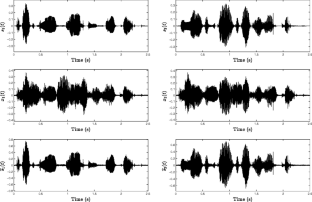Abstract
In this paper, we propose analytical formulas that involve second-order statistics for separating two signals. The method utilizes source decorrelation and correlation function diversity. In particular, the proposed SOBAS (second-order blind analytical separation) algorithm differs from the ASOBI (analytical second-order blind identification) algorithm in that it does not require prior knowledge or estimation of the noise variance. Computer simulations demonstrate the effectiveness of the proposed method.






Similar content being viewed by others
References
Abed-Meraim K, Attallah S, Lim T, Damen M (2000) A blind interference canceller in DS-CDMA. In: IEEE International Symposium on Spread Spectrum Techniques and Applications. Parsippany, pp 358–362
Aïssa-El-Bey A, Abed-Meraim K, Grenier Y (2007) Underdetermined blind audio source separation using modal decomposition. EURASIP J Audio Speech Music Process 2007(85438):1–15
Aziz-Sbaï SM, Aïssa-El-Bey A, Pastor D (2012) Contribution of statistical tests to sparseness-based blind source separation. EURASIP J Appl Signal Process 2012:169
Belouchrani A, Abed-Meraim K, Cardoso JF, Moulines E (1997) A blind source separation technique using second-order statistics. IEEE Trans Signal Process 45(2):434–444. https://doi.org/10.1109/78.554307
Belouchrani A, Bourennane E, Abed-Meraim K (2006) A closed form solution for the blind separation of two sources from two sensors using second order statistics. In: European Signal processing conferenc (EUSIPCO). Florence
Comon P, Jutten C (2010) Handbook of blind source separation: independent component analysis and applications, 1st edn. Academic Press
Durán-Díaz I, Cruces-Alvarez SA (2007) A joint optimization criterion for blind DS-CDMA detection. EURASIP J Adv Signal Process 2007(79248):1–11
Hypvarinen A, Karhunen J, Oja E (2001) Independent component analysis. Wiley
Itakura F, Saito S (1968) Analysis synthesis telephony based on the maximum likelihood method. In: 6th International Congress on Acoustics, vol C. Tokyo, pp 17–20
Rouxel A, Guennec D L, Macchi O (2000) Unsupervised adaptive separation of impulse signals applied to EEG analysis. In: IEEE International Conference on Acoustics, Speech, Signal Processing (ICASSP), vol 1. Istanbul, pp 420-423
Varajarajan V, Krolik J (2001) Multichannel system identification methods for sensor array calibration in uncertain multipath environments. In: IEEE Signal processing workshop on statistical signal processing (SSP). Singapore, pp 297–300
Wang Z, Zhang X, Cao T (2006) Intelligent control and automation: International Conference on Intelligent Computing, ICIC 2006 Kunming, China, August 16–19, 2006, chap. A new blind source separation algorithm based on second-order statistics for TITO. Springer, Berlin, pp 29–34. https://doi.org/10.1007/978-3-540-37256-1_4
Author information
Authors and Affiliations
Corresponding author
Rights and permissions
About this article
Cite this article
Meziane, A.M.B., Chonavel, T., Aïssa-El-Bey, A. et al. An analytical derivation for second-order blind separation of two signals. Ann. Telecommun. 73, 711–717 (2018). https://doi.org/10.1007/s12243-018-0635-6
Received:
Accepted:
Published:
Issue Date:
DOI: https://doi.org/10.1007/s12243-018-0635-6


